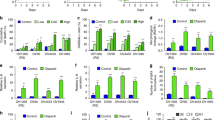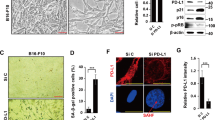Abstract
Cellular senescence guards against cancer and modulates aging; however, the underlying mechanisms remain poorly understood. Here, we show that genotoxic drugs capable of inducing premature senescence in normal and cancer cells, such as 5-bromo-2′-deoxyuridine (BrdU), distamycin A (DMA), aphidicolin and hydroxyurea, persistently activate Janus kinase–signal transducer and activator of transcription (JAK/STAT) signaling and expression of interferon-stimulated genes (ISGs), such as MX1, OAS, ISG15, STAT1, PML, IRF1 and IRF7, in several human cancer cell lines. JAK1/STAT-activating ligands, interleukin 10 (IL10), IL20, IL24, interferon γ (IFNγ), IFNβ and IL6, were also expressed by senescent cells, supporting autocrine/paracrine activation of JAK1/STAT. Furthermore, cytokine genes, including proinflammatory IL1, tumor necrosis factor and transforming growth factor families, were highly expressed. The strongest inducer of JAK/STAT signaling, cytokine production and senescence was BrdU combined with DMA. RNA interference-mediated knockdown of JAK1 abolished expression of ISGs, but not DNA damage signaling or senescence. Thus, although DNA damage signaling, p53 and RB activation, and the cytokine/chemokine secretory phenotype are apparently shared by all types of senescence, our data reveal so far unprecedented activation of the IFNβ–STAT1–ISGs axis, and indicate a less prominent causative role of IL6-JAK/STAT signaling in genotoxic drug-induced senescence compared with reports on oncogene-induced or replicative senescence. These results highlight shared and unique features of drug-induced cellular senescence, and implicate induction of cancer secretory phenotype in chemotherapy.
This is a preview of subscription content, access via your institution
Access options
Subscribe to this journal
Receive 50 print issues and online access
$259.00 per year
only $5.18 per issue
Buy this article
- Purchase on Springer Link
- Instant access to full article PDF
Prices may be subject to local taxes which are calculated during checkout






Similar content being viewed by others
References
Acosta JC, O'Loghlen A, Banito A, Guijarro MV, Augert A, Raguz S et al. (2008). Chemokine signaling via the CXCR2 receptor reinforces senescence. Cell 133: 1006–1018.
Bartek J, Lukas J, Bartkova J . (2007). DNA damage response as an anti-cancer barrier: damage threshold and the concept of ‘conditional haploinsufficiency’. Cell Cycle 6: 2344–2347.
Bartkova J, Rezaei N, Liontos M, Karakaidos P, Kletsas D, Issaeva N et al. (2006). Oncogene-induced senescence is part of the tumorigenesis barrier imposed by DNA damage checkpoints. Nature 444: 633–637.
Bringold F, Serrano M . (2000). Tumor suppressors and oncogenes in cellular senescence. Exp Gerontol 35: 317–329.
Campisi J . (2005). Senescent cells, tumor suppression, and organismal aging: good citizens, bad neighbors. Cell 120: 513–522.
Campisi J, d'Adda di Fagagna F . (2007). Cellular senescence: when bad things happen to good cells. Nat Rev Mol Cell Biol 8: 729–740.
Collado M, Blasco MA, Serrano M . (2007). Cellular senescence in cancer and aging. Cell 130: 223–233.
Commins S, Steinke JW, Borish L . (2008). The extended IL-10 superfamily: IL-10, IL-19, IL-20, IL-22, IL-24, IL-26, IL-28, and IL-29. J Allergy Clin Immunol 121: 1108–1111.
Coussens LM, Werb Z . (2002). Inflammation and cancer. Nature 420: 860–867.
Di Micco R, Fumagalli M, Cicalese A, Piccinin S, Gasparini P, Luise C et al. (2006). Oncogene-induced senescence is a DNA damage response triggered by DNA hyper-replication. Nature 444: 638–642.
DiTullio Jr RA, Mochan TA, Venere M, Bartkova J, Sehested M, Bartek J et al. (2002). 53BP1 functions in an ATM-dependent checkpoint pathway that is constitutively activated in human cancer. Nat Cell Biol 4: 998–1002.
Engstrom JU, Kmiec EB . (2007). Manipulation of cell cycle progression can counteract the apparent loss of correction frequency following oligonucleotide-directed gene repair. BMC Mol Biol 8: 9–25.
Fisher PB . (2005). Is mda-7/IL-24 a ‘magic bullet’ for cancer? Cancer Res 65: 10128–10138.
Halazonetis TD, Gorgoulis VG, Bartek J . (2008). An oncogene-induced DNA damage model for cancer development. Science 319: 1352–1355.
Han Z, Wei W, Dunaway S, Darnowski JW, Calabresi P, Sedivy J et al. (2002). Role of p21 in apoptosis and senescence of human colon cancer cells treated with camptothecin. J Biol Chem 277: 17154–17160.
Hayflick L, Moorhead PS . (1961). The serial cultivation of human diploid cell strains. Exp Cell Res 25: 585–621.
Honda K, Yanai H, Takaoka A, Taniguchi T . (2005). Regulation of the type I IFN induction: a current view. Int Immunol 17: 1367–1378.
Chang BD, Broude EV, Dokmanovic M, Zhu H, Ruth A, Xuan Y et al. (1999). A senescence-like phenotype distinguishes tumor cells that undergo terminal proliferation arrest after exposure to anticancer agents. Cancer Res 59: 3761–3767.
Chelbi-Alix MK, Pelicano L, Quignon F, Koken MH, Venturini L, Stadler M et al. (1995). Induction of the PML protein by interferons in normal and APL cells. Leukemia 9: 2027–2033.
Imada K, Leonard WJ . (2000). The Jak-STAT pathway. Mol Immunol 37: 1–11.
Janderova-Rossmeislova L, Novakova Z, Vlasakova J, Philimonenko V, Hozak P, Hodny Z . (2007). PML protein association with specific nucleolar structures differs in normal, tumor and senescent human cells. J Struct Biol 159: 56–70.
Kaynor C, Xin M, Wakefield J, Barsoum J, Qin XQ . (2002). Direct evidence that IFN-beta functions as a tumor-suppressor protein. J Interferon Cytokine Res 22: 1089–1098.
Kim TK, Maniatis T . (1997). The mechanism of transcriptional synergy of an in vitro assembled interferon-beta enhanceosome. Mol Cell 1: 119–129.
Krtolica A, Parrinello S, Lockett S, Desprez PY, Campisi J . (2001). Senescent fibroblasts promote epithelial cell growth and tumorigenesis: a link between cancer and aging. Proc Natl Acad Sci USA 98: 12072–12077.
Kuilman T, Michaloglou C, Vredeveld LC, Douma S, van Doorn R, Desmet CJ et al. (2008). Oncogene-induced senescence relayed by an interleukin-dependent inflammatory network. Cell 133: 1019–1031.
Kuilman T, Peeper DS . (2009). Senescence-messaging secretome: SMS-ing cellular stress. Nat Rev Cancer 9: 81–94.
Kulaeva OI, Draghici S, Tang L, Kraniak JM, Land SJ, Tainsky MA . (2003). Epigenetic silencing of multiple interferon pathway genes after cellular immortalization. Oncogene 22: 4118–4127.
Lin WW, Karin M . (2007). A cytokine-mediated link between innate immunity, inflammation, and cancer. J Clin Invest 117: 1175–1183.
Mallette FA, Ferbeyre G . (2007). The DNA damage signaling pathway connects oncogenic stress to cellular senescence. Cell Cycle 6: 1831–1836.
Mallette FA, Gaumont-Leclerc MF, Ferbeyre G . (2007). The DNA damage signaling pathway is a critical mediator of oncogene-induced senescence. Genes Dev 21: 43–48.
Michaloglou C, Vredeveld LCW, Soengas MS, Denoyelle C, Kuilman T, van der Horst CMAM et al. (2005). BRAFE600-associated senescence-like cell cycle arrest of human naevi. Nature 436: 720–724.
Michishita E, Nakabayashi K, Suzuki T, Kaul SC, Ogino H, Fujii M et al. (1999). 5-Bromodeoxyuridine induces senescence-like phenomena in mammalian cells regardless of cell type or species. J Biochem (Tokyo) 126: 1052–1059.
Minagawa S, Nakabayashi K, Fujii M, Scherer SW, Ayusawa D . (2005). Early BrdU-responsive genes constitute a novel class of senescence-associated genes in human cells. Exp Cell Res 304: 552–558.
Moiseeva O, Mallette FA, Mukhopadhyay UK, Moores A, Ferbeyre G . (2006). DNA damage signaling and p53-dependent senescence after prolonged {beta}-interferon stimulation. Mol Biol Cell 17: 1583–1592.
Mushinski JF, Nguyen P, Stevens LM, Khanna C, Lee S, Chung EJ et al. (2009). Inhibition of tumor cell motility by the interferon-inducible GTPase MxA. J Biol Chem 284: 15206–15214.
Pamment J, Ramsay E, Kelleher M, Dornan D, Ball KL . (2002). Regulation of the IRF-1 tumour modifier during the response to genotoxic stress involves an ATM-dependent signalling pathway. Oncogene 21: 7776–7785.
Parrinello S, Coppe JP, Krtolica A, Campisi J . (2005). Stromal-epithelial interactions in aging and cancer: senescent fibroblasts alter epithelial cell differentiation. J Cell Sci 118: 485–496.
Qing Y, Stark GR . (2004). Alternative activation of STAT1 and STAT3 in response to interferon-gamma. J Biol Chem 279: 41679–41685.
Ronni T, Matikainen S, Lehtonen A, Palvimo J, Dellis J, Van Eylen F et al. (1998). The proximal interferon-stimulated response elements are essential for interferon responsiveness: a promoter analysis of the antiviral MxA gene. J Interferon Cytokine Res 18: 773–781.
Sager R . (1991). Senescence as a mode of tumor suppression. Environ Health Perspect 93: 59–62.
Serrano M, Lin AW, McCurrach ME, Beach D, Lowe SW . (1997). Oncogenic ras provokes premature cell senescence associated with accumulation of p53 and p16INK4a. Cell 88: 593–602.
Shuai K, Liu B . (2005). Regulation of gene-activation pathways by PIAS proteins in the immune system. Nat Rev Immunol 5: 593–605.
Schmitt CA . (2007). Cellular senescence and cancer treatment. Biochim Biophys Acta 1775: 5–20.
Suzuki T, Michishita E, Ogino H, Fujii M, Ayusawa D . (2002). Synergistic induction of the senescence-associated genes by 5-bromodeoxyuridine and AT-binding ligands in HeLa cells. Exp Cell Res 276: 174–184.
Suzuki T, Yaginuma M, Oishi T, Michishita E, Ogino H, Fujii M et al. (2001). 5-Bromodeoxyuridine suppresses position effect variegation of transgenes in HeLa cells. Exp Cell Res 266: 53–63.
Timmermann S, Hinds PW, Munger K . (1998). Re-expression of endogenous p16ink4a in oral squamous cell carcinoma lines by 5-aza-2′-deoxycytidine treatment induces a senescence-like state. Oncogene 17: 3445–3453.
Toussaint O, Royer V, Salmon M, Remacle J . (2002). Stress-induced premature senescence and tissue ageing. Biochem Pharmacol 64: 1007–1009.
van Boxel-Dezaire AHH, Rani MRS, Stark GR . (2006). Complex modulation of cell type-specific signaling in response to type i interferons. Immunity 25: 361–372.
von Zglinicki T . (2002). Oxidative stress shortens telomeres. Trends Biochem Sci 27: 339–344.
Yogev O, Anzi S, Inoue K, Shaulian E . (2006). Induction of transcriptionally active Jun proteins regulates drug-induced senescence. J Biol Chem 281: 34475–34483.
Acknowledgements
We thank Ondřej Horváth and Michal Koc for assistance, and Jan Frič and Ondřej Staněk for help with ELISA. This work was supported by the Grant Agency of the Academy of Sciences of the Czech Republic (Project IAA500390501), the Grant Agency of the Czech Republic (Project 204/08/1418), the European Commission (project TRIREME), Grant LC545 of the Ministry of Education, Youth and Sports of the Czech Republic, and the Institutional Grant (Project AV0Z5039906).
Author information
Authors and Affiliations
Corresponding authors
Additional information
Supplementary Information accompanies the paper on the Oncogene website (http://www.nature.com/onc)
Rights and permissions
About this article
Cite this article
Novakova, Z., Hubackova, S., Kosar, M. et al. Cytokine expression and signaling in drug-induced cellular senescence. Oncogene 29, 273–284 (2010). https://doi.org/10.1038/onc.2009.318
Received:
Revised:
Accepted:
Published:
Issue Date:
DOI: https://doi.org/10.1038/onc.2009.318
Keywords
This article is cited by
-
Bioinformatics analyses of combined databases identify shared differentially expressed genes in cancer and autoimmune disease
Journal of Translational Medicine (2023)
-
Dynamics of redox signaling in aging via autophagy, inflammation, and senescence
Biogerontology (2023)
-
Nociceptin/orphanin FQ opioid receptor (NOP) selective ligand MCOPPB links anxiolytic and senolytic effects
GeroScience (2022)
-
IFNγ induces oxidative stress, DNA damage and tumor cell senescence via TGFβ/SMAD signaling-dependent induction of Nox4 and suppression of ANT2
Oncogene (2016)
-
Opposite Effects of M1 and M2 Macrophage Subtypes on Lung Cancer Progression
Scientific Reports (2015)



